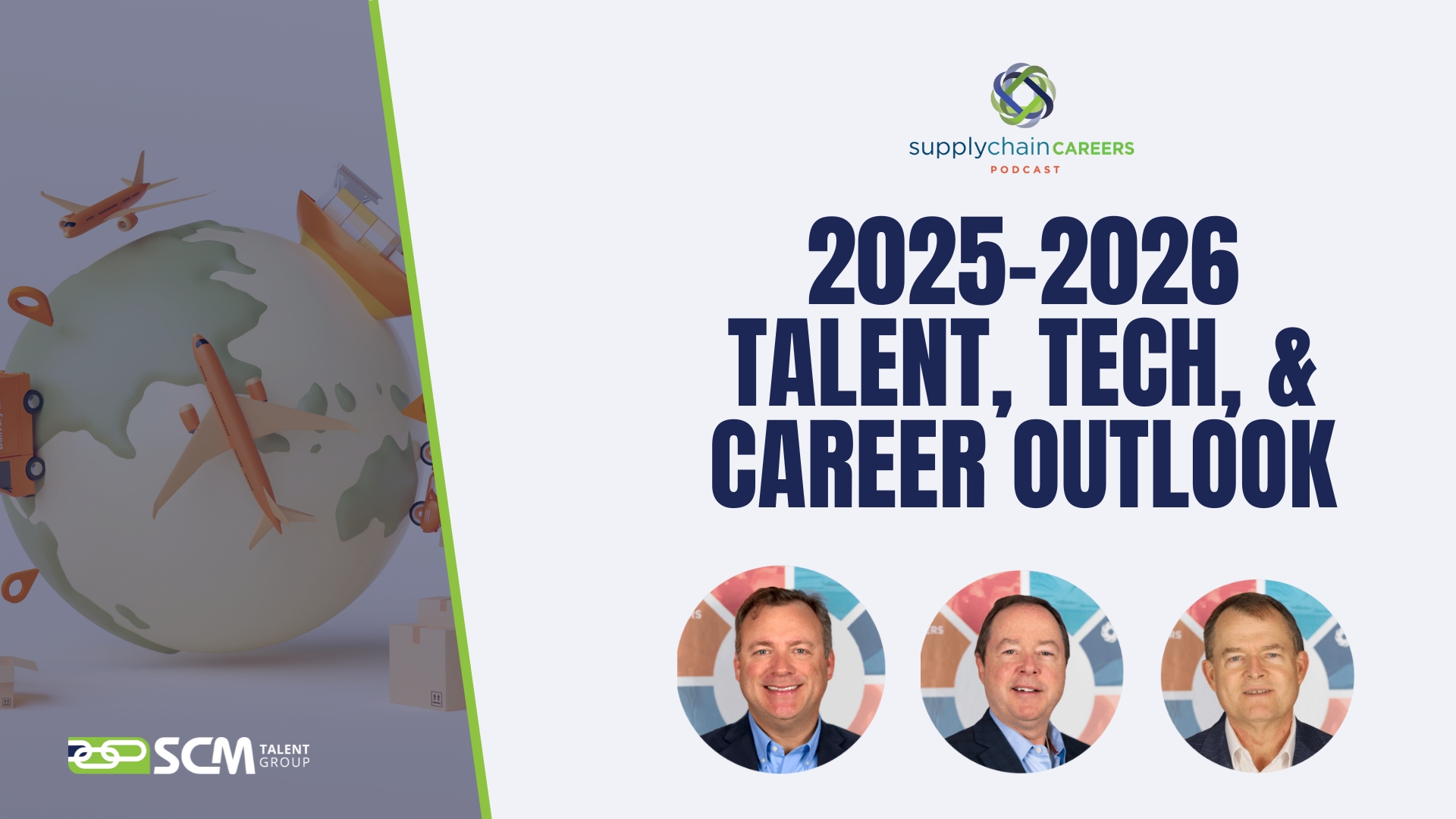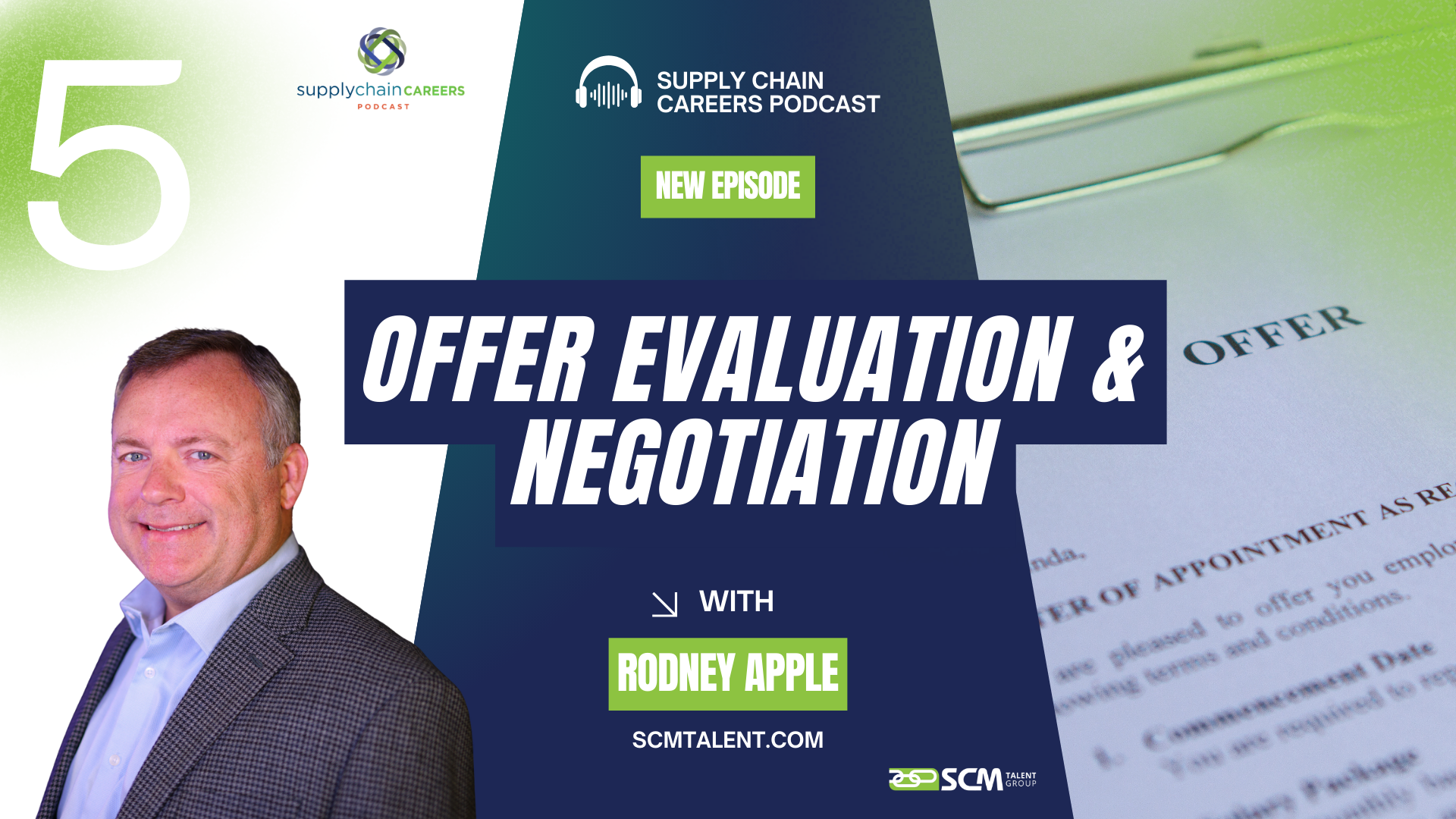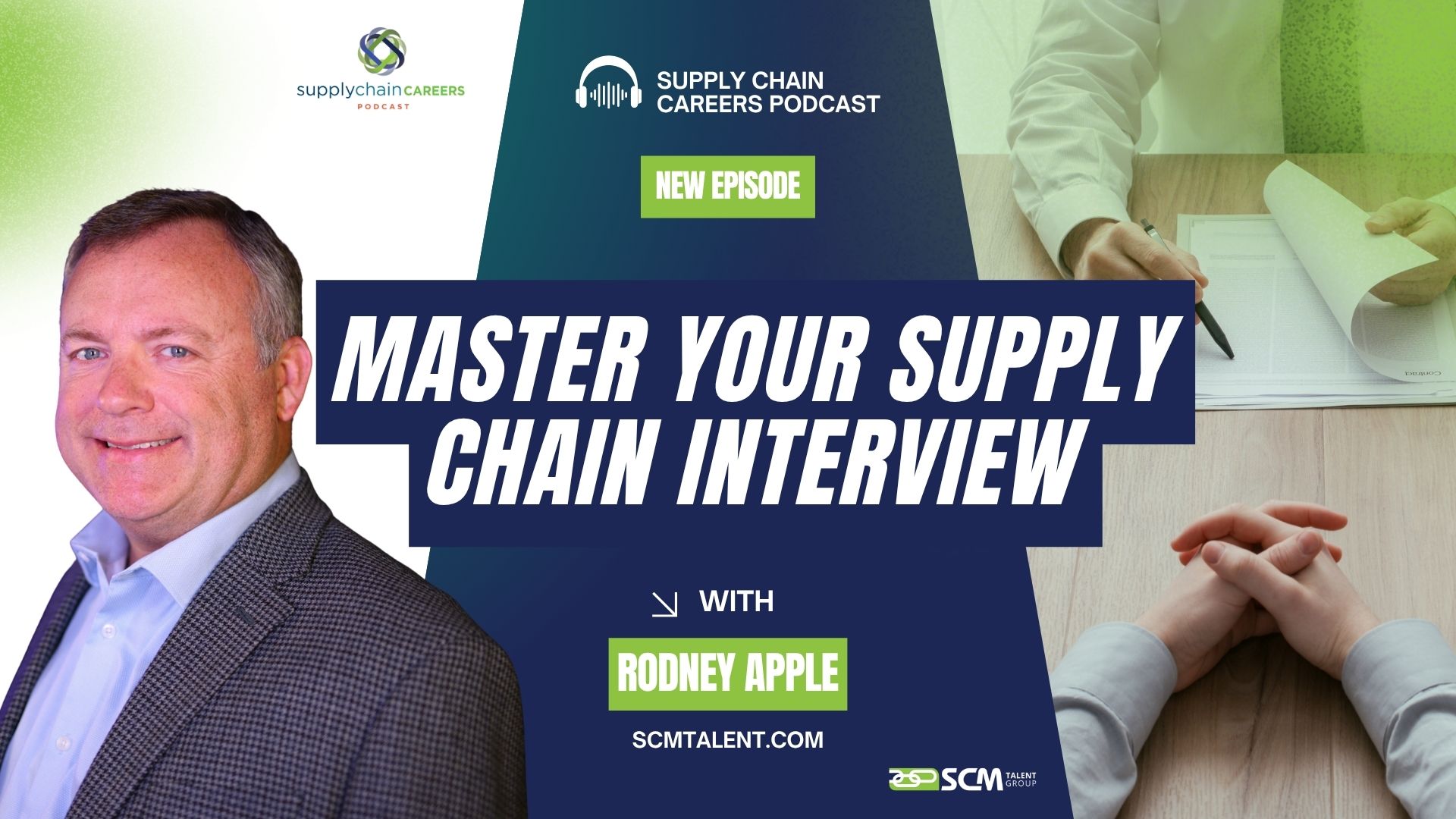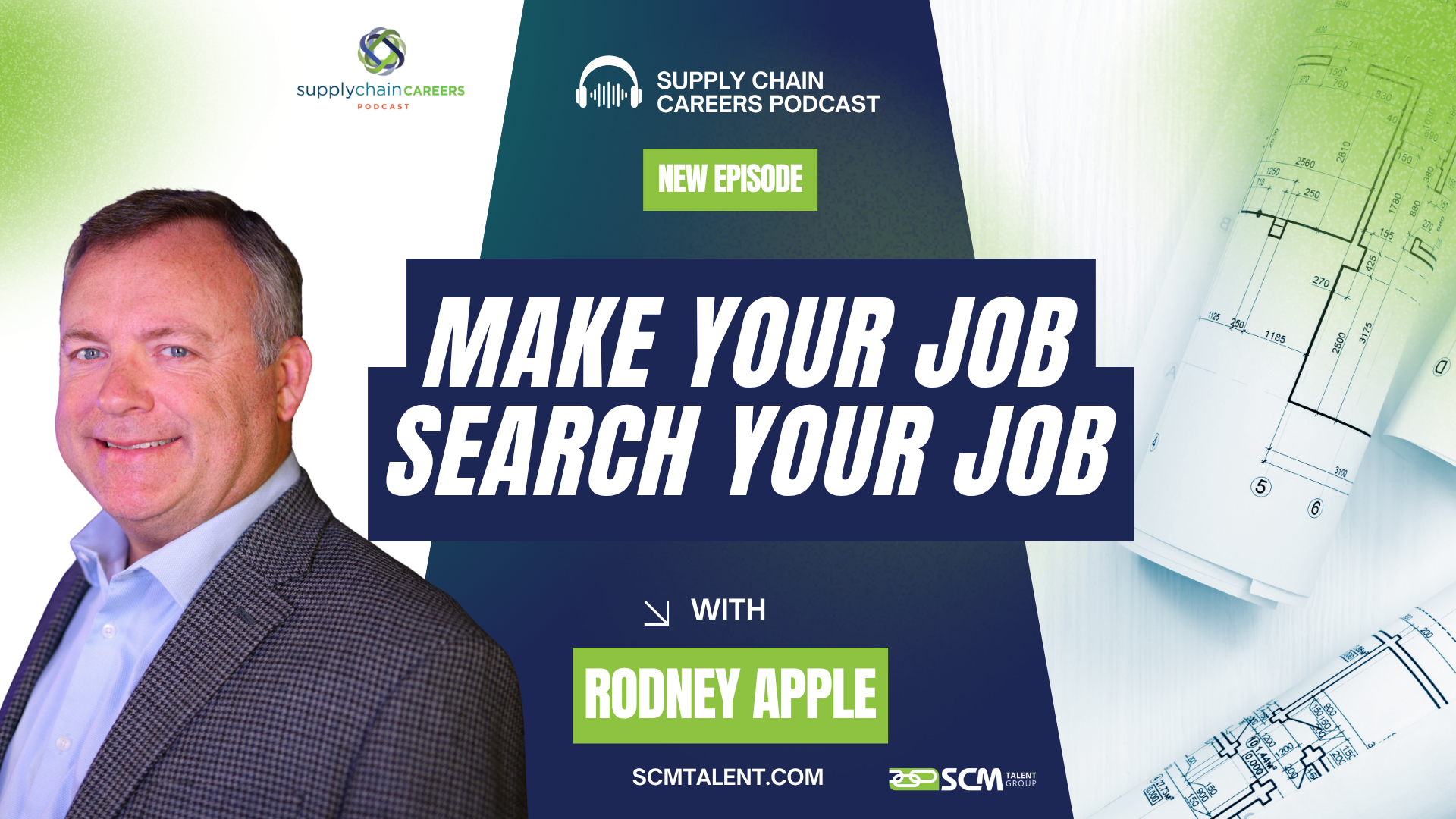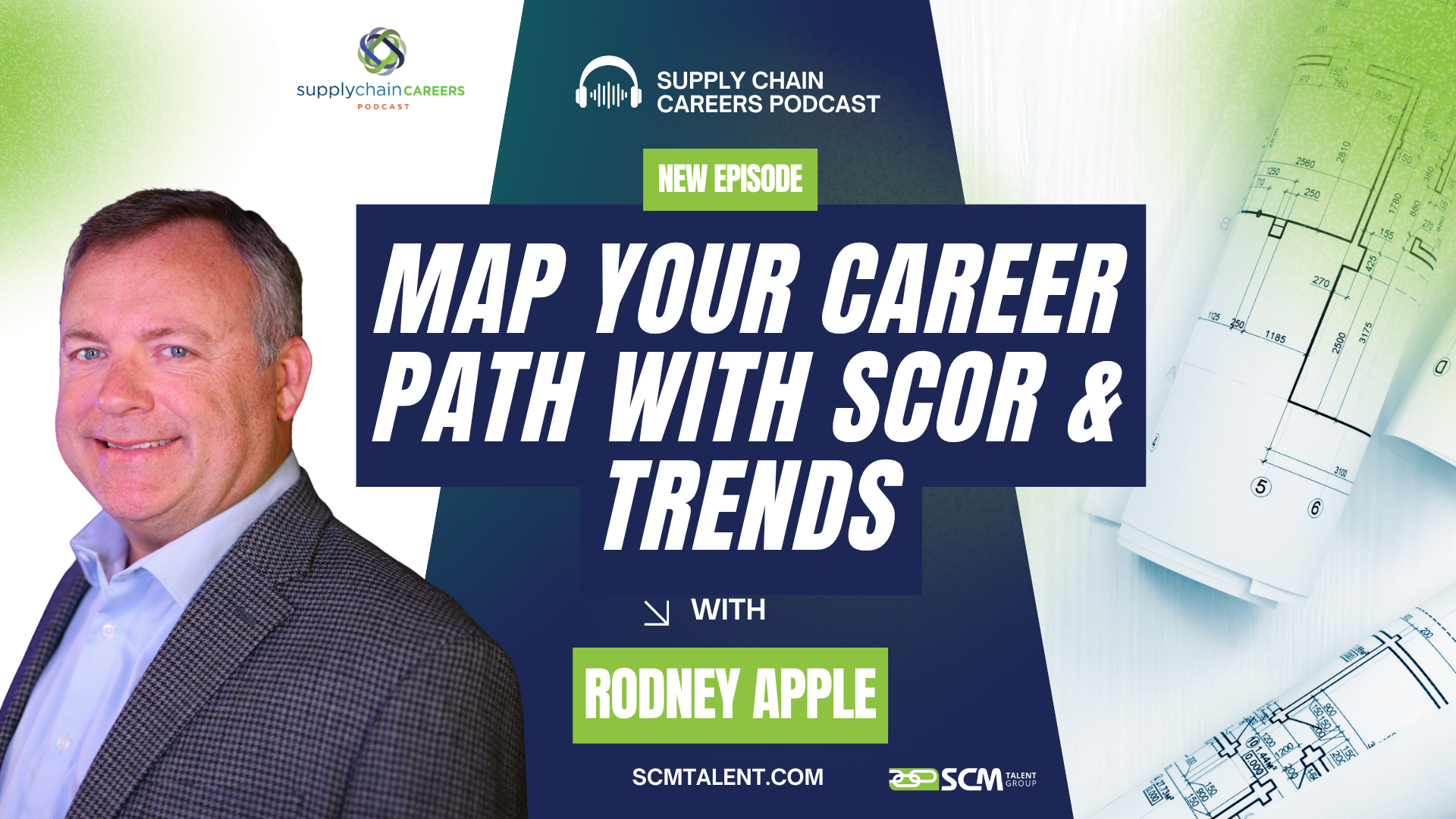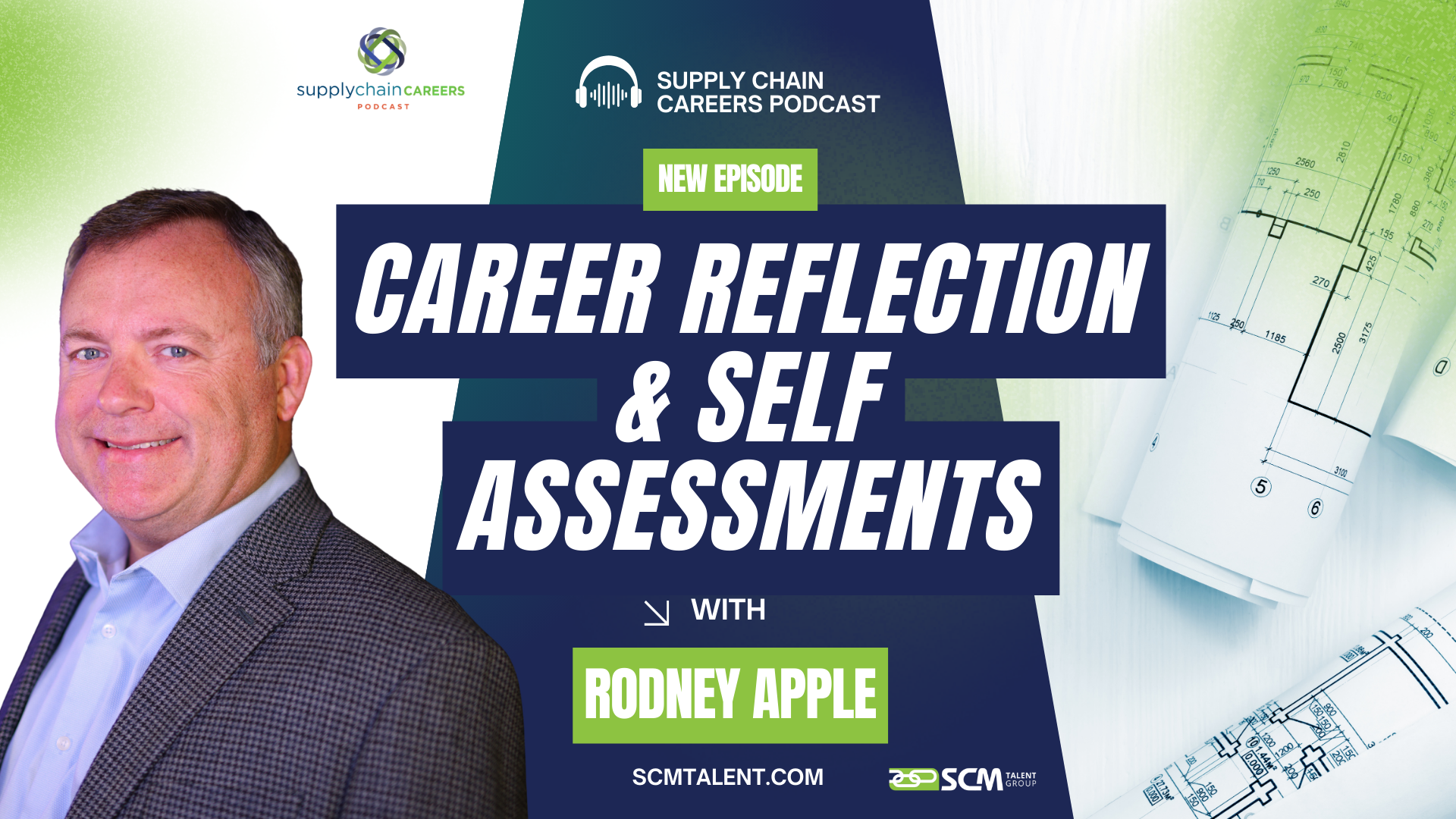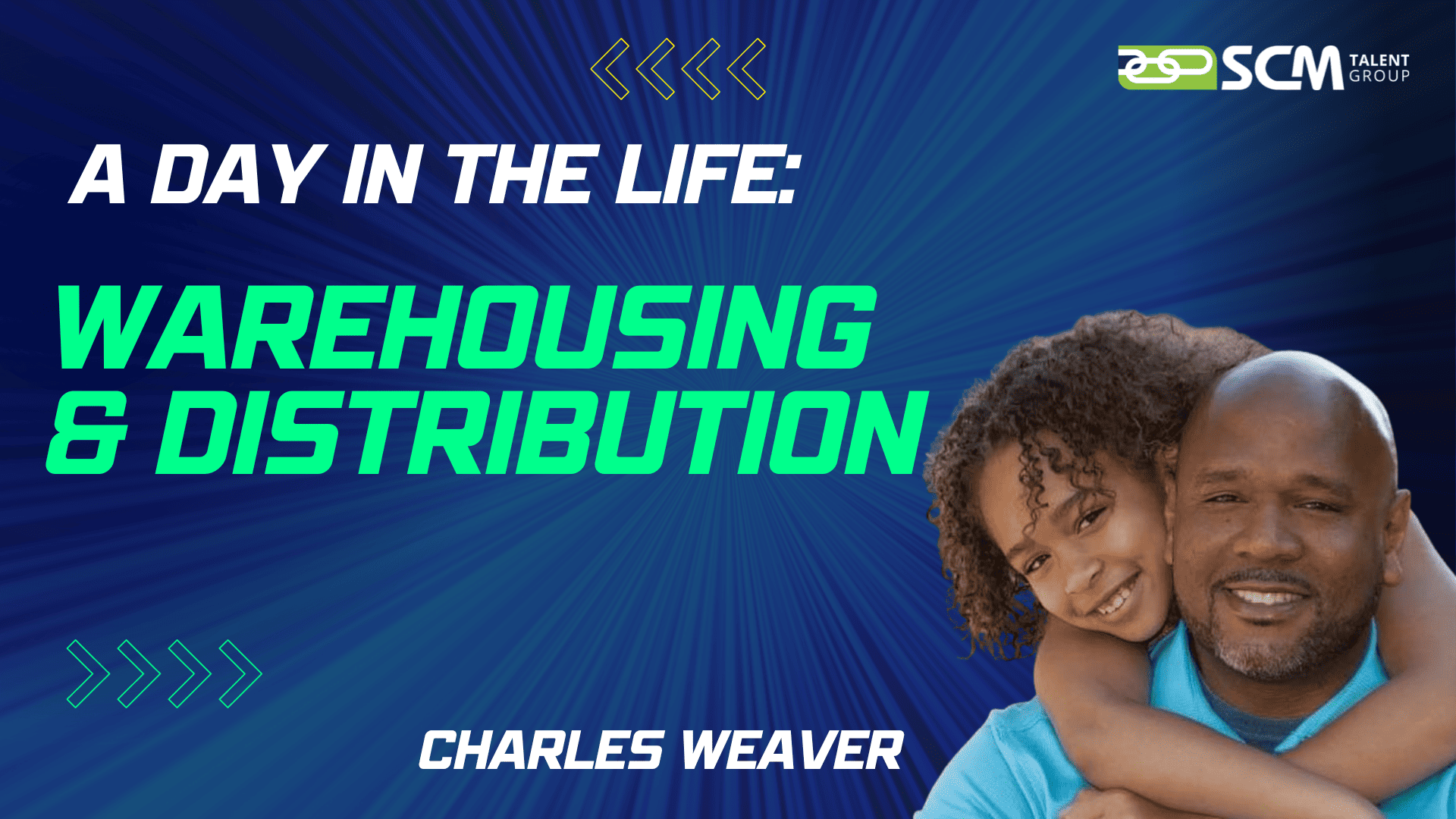
Podcast: A Day In The Life of a Warehouse and Distribution Professional
Hosts: Rodney Apple
In This Episode:
In this episode of A Day in the Life of a Supply Chain Professional podcast, host Rodney Apple interviews Charles Weaver, a veteran in warehousing and distribution with 29 years of experience. Weaver discusses his transition from the military into supply chain. He emphasizes the importance of “gray areas” and soft skills in civilian roles. Weaver expands upon the day-to-day activities in a distribution center and touches on key roles including metrics and safety protocols. Weaver also mentions that problems will inevitably arise and how you deal with them defines your leadership. He values training the next generation and highlights the satisfaction of solving logistical puzzles in his daily work.
We also explore some of the following topics:
- Day-to-day responsibilities of Charles’s role;
- Aspects of Charles’s role that he finds the most enjoyable;
- How professionals can progress beyond their current position.
Who is Charles Weaver?
Charles is a devoted husband and father who values the principles and effectiveness of “Servant Leadership.” Striving daily to serve as a helpful component to others, his life creed is “Helping people become better, stronger versions of themselves.” As an active and forward-thinking leader, he believes that earning a team’s trust begins with cultivating quality relationships. While some may flourish in complexity, he diligently works to simplify procedures in the workplace. Committed to investing in his team, he provides education, insights, and unique character and team-building methods.
For him, serving and helping others is not just a career obligation but a lifelong commitment, regardless of the business organization of which he is a part.
[00:00:00] Mike Ogle: Welcome to another episode in the day of the life series of the supply chain careers podcast. In this series, you hear directly from supply chain professionals about their current positions, their day to day responsibilities, what they enjoy about their positions and how to best prepare yourself to be successful, to do the work plus what it takes to get there and continue advancing along the many career paths in supply chain.
This podcast is made possible by SCM talent group, the industry leading supply chain executive search firm. Visit SCM talent group at scmtalent. com. To search for or to post supply chain jobs? Visit the supply chain job [email protected]. Are you tired of struggling to optimize your supply chain?
Look no further than Profit Point the experts in supply chain, network design and technology integration solutions. Visit profit point.com to learn more. That’s profit pt.com.
[00:01:10] Rodney Apple: Welcome to the Supply Chain Careers podcast. This is the day in the life of a supply chain professional series. Today we have a special guest Chuck Weaver who works in warehousing and distribution and quite a few other things, but today we’re going to cover the day in the life of working in a distribution center warehousing environment.
[00:01:34] Charles Weaver: Thank you, Rodney. I appreciate you for having me.
[00:01:36] Rodney Apple: Absolutely. Pleasure to have you on. So Could you tell us how long you’ve been working in this particular field and what led you to pursue this type of work?
[00:01:46] Charles Weaver: To make it plain and simple, Rodney – so this is going to be year 29 August and that’s everything from the terms.
Change as time goes along. It’s a warehouse. It’s a fulfillment center. It’s a distribution center. But at the end of the day, it’s a very big facility where we store and ship products. Right? So, actually, my supply chain career started in the United States Marine Corps. And then I came upon just understanding and knowing that I had a.
Talent and skill set for making 1 object move from 1 place to another plain and simple, wonderful.
[00:02:27] Rodney Apple: And I may follow up on that question. We thank you for your service as well. And this, this could apply to our audience that may be working in the military at the moment, trying to think of. Where can I take my career on finishing the military?
We do see a lot of people transition from the operation side. If they work in logistics, warehousing, would you maybe describe how that transition from the military into your first position, what were some of the trials, tribulations and how you made that transition?
[00:02:57] Charles Weaver: Sure. The first transition from military to civilian life is the.
Removal of the black and white environment. Once we go into the civilian environment, there is an absolute crucial need to understand gray. And when you understand gray, and you understand, while there may be. Authoritative positions, you’ve got titles like general manager, senior ops manager, warehouse supervisor, warehouse operations manager, team lead, you’ve got those different kind of authority figures there.
At the end of the day, what’s most important is that you never forget. What you learned in the military and what I know from good leadership and mentorship is this, while leadership is defined as the practice of instilling belief in a group of individuals to accomplish a goal or objective, what you’re also doing is helping people one, and then helping people to realize that they are capable enough to Complete and successfully accomplish whatever you ask of them or whatever the job task requires.
[00:04:14] Rodney Apple: Thank you. And that is true. It is black and white a bit more command and control from a leadership and you have to almost completely walk away from that. But a lot of it is influencing and, uh, you know, getting people to understand. Here’s the task. Here’s how you do it and motivating them. To do these things as well.
So could you describe for our audience, your typical, we’ve got the hard skills, we’ve got to learn how to manage inventory, things like that. And you’ve got the soft skills, the all important soft skills that you, I think everybody in supply chain has to have. Could you just describe like from a high level, what it takes to get into a role where you’re supervising a team of the frontline associates?
[00:04:55] Charles Weaver: So I think first and foremost is to understand this. People are not metrics. The better yet, people are not numbers. People drive numbers, right? People and their performance gives you the metric optics and whatnot. Know this first and foremost. What is most important is the safety of your team.
Understanding, especially if you’re walking into that warehouse, D. C. F. C. environment. You definitely need to make industrial safety best practices a mainstay. You need to keep it a constant in your operational cadence. You need to have those acronyms like OSHA, NIOSH. You need to have the five S principles and just general housekeeping because it comes down to having people operate as a team and operate in each other’s best interest.
So, when I say I want a safe environment, and I’m coaching a safe environment, and I’m leading a safe environment, the associates or team members. Are driving those best practices and those expectations there, your front line runners there. You’re molding them into leading without having a leadership title because they want the best for themselves and for others.
And at the end of the day, it’s https: otter. ai
Is the same condition that they need to leave it and I owe that to them.
[00:06:39] Rodney Apple: Amen. Safety is number one. Could you take the audience through day in the life? So you’re going into work, you’re entering the building. What occurs from there? Could you kind of break that down and maybe talk about the key roles from the inbound outbound and the process in the middle of picking and put away,
[00:06:55] Charles Weaver: Absolutely. So in coming in, in my role as an operations manager and spending a large portion of my career as a supervisor, while there are some nuances between understanding things from a larger scope and monthly semi annual annual perspectives, the main thing where any supervisor or ops manager is going to come in Is a taking into account what happened yesterday, what were the impacts from the previous shift, what your handoff is going to look like, right?
And how much the previous shift has either set you up for success or just due to the operation in itself. You’re starting off with challenges. Maybe you’re starting off with a doc that’s completely locked down with freight because there wasn’t. A put away presence there. So you’re taking into account the status of your operation.
And I’m talking about when I say what the docs look like from an inbound perspective, what the freight dimensions look like. Are we talking about large bulky items that are staged? Are we talking about small parcel items that are going to small bin locations, all the diversity in there? You’re taking that into play.
All right. Of course. Your head count, you got to take into account. Hopefully all of the associates slash team members have done the right thing and have, uh, whether it’s phone, whether it’s a now they do QR codes where you can report in your absence and things of that nature, but you’re taking in to account what your head count looks like and the attendance impacts and then you’re structuring your head count.
Times your units per hour per your department that you’re in. If you’re in inbound, you might have a receiving units per hour UPH. And then the 2nd part to that is the freight has to be cleared off of the dock. So there’s your put away UPH, right? And then on the outbound side, in order to get it to the truck and at the end of the day to get it shipped, the product has to be picked.
So there’s your. Picking UPH and then whatever your shipping method is, whether you’re, whether your pickers are dropping off freight and it’s going through some form of a conveyor line system with technology. If you’re going straight to the trailer with a cart, if you’re dropping those small parcel items off at a packing station and they’re being packed up and then sent off, but you’re factoring all those things into your equation, what your staffing is going to look like.
What’s your critical pieces of the operation are dependent upon what’s your handoff looks like again, I may not be able to go as hard as I want to and put away operations, or I may have to because this doc is locked down with freight everywhere. I can’t receive anything. So I need to have a momentary delay to that process and then take partnerships with my put away driver force to put them in mass to get this stuff cleaned out.
So you’re looking at your operations and you’re developing a flow, right? So you’re the main strategy between inbound and outbound is. What does the product look like coming off of the truck, hitting the staging lanes and then going into the racks? What does the product look like coming off the truck?
And if it’s a cross dock operation, then we’re swinging it right on to another trailer to get it shipped out outbound. The same thing. What does that look like? When I’m picking the product, my cut off times for trailers. Things of that nature dwell time for straight for staging trailers and carrier response, all things that go in the element of first in and first out order so that you’re making sure that you’re meeting your service level agreements.
So, you’re really developing the flow and the strategical timing of everything and everything is meeting. The term that I’m using as of late is seamless flow. We’re trying to achieve as much seamless flow as possible, barring the nuances of the operation in general.
[00:11:27] Rodney Apple: Well, that was very thorough. Thank you, Chuck.
So a lot of things can happen that can throw off that schedule. So when you think about you’re in this operation environment, call it within the four walls, you still have your stakeholders. Internally that you have to interface with for success. You mentioned the handoff from shifts, and there’s also the handoffs from departments to create that seamless operation and ultimately getting the product to the customer on time where they want it, uh, when they want it without damaging it or losing product in the process, right?
Who do you interface with internally? And is there any external contact, whether it be stores or whether it be your end customer? That’s waiting for that product at the last mile. Could you maybe talk about that? Yeah,
[00:12:07] Charles Weaver: absolutely. I would say from an external standpoint, our partners exist with other sites or other DCs or FCs again, whatever the nomenclature is indicative of, but as an operations manager at Wayfair, when it comes down to the relationships that go on outside of my operation, typically are.
Partnering with other sites, partnering with remote it teams for help with our scanner technologies and things of that nature, maybe some external quality control resources and stuff like that. So still contained within the operation, the customer side of it. I would say there are some interfaces that we have to have with our customer service when things don’t go right.
When there are late shipments, when we haven’t met expectations in the fulfillment center. So now all of a sudden, because technology is what it is, if we’re late in the warehouse, the customer’s going to know about it quickly. They’re going to automatically get a, hello, Rodney, we want to inform you that your shipment while it was scheduled for the 14th is now arriving on the 21st.
We apologize for this convenience and so forth and so forth. And then Rodney says. Got it. However, I want to know why it was late. So we have to account for that. We have to talk to our customer service, our senior management, sometimes headquarters entities and explain that and talk about where the process fell short and what we’re going to do to fix it.
So while the message may get to the customer that their product is coming late, there’s sometimes you can salvage the 21st and where you can pull it back and maybe get a few days of customer service level back in there and make it the 18th, who knows, but you’ve got to try something. And then if it’s not necessarily the.
Process that’s impacted the unit. It may be the data and that needs to be troubleshot. What happened in that order flow that interrupted it and somehow caused an error that flagged it or stopped it, halted it, made it look like it shipped when it didn’t so forth and so forth. So that’s what that process looks like.
It takes a lot of teamwork. You can’t be in a silo trying to do it. I partner with my supervisors all the time about the life cycle and the pathway of units. Uh, so that we’re understanding exactly what happened and what happens and we’re getting the right feedback to that customer service point because the truth is what’s necessary.
You run to your truth. Don’t run away from it. Don’t give, don’t make up an answer. Try to make something look like it isn’t. You need to, we need to just go ahead and accept the fact that we made a mistake. We’re wrong and we’ll learn from it in any operations role. It
[00:15:03] Rodney Apple: It takes the whole team. You’ve got to have a good process, but things are going to go wrong and you have to accept it and solve it, move forward.
And that’s a lot of operations jobs, whether you’re manufacturing or anywhere else. But you guys are what keeps everything ticking. So we could not do it without you. And we think it’s a very exciting career path.
[00:15:26] Mike Ogle: During this short break, we recognize that this podcast is made possible by SCM Talent Group, the industry leading supply chain executive search firm.
Visit SCM Talent Group. At SCM talent.com to search for or to post supply chain jobs, visit the supply chain job [email protected]. Are you tired of struggling to optimize your supply chain? Look no further than Profit Point. Be experts in supply chain, network design and technology integration solution.
Visit profit point.com to learn more. That’s profit pt.com.
[00:16:05] Rodney Apple: And on that note, my next question, could you tell us what you enjoy the most about working in the distribution warehouse fulfillment operations?
[00:16:13] Charles Weaver: Absolutely. Absolutely. I enjoy because this is again, a talent. This is something that I have as we can call it.
Well, it’s just a box moving from point A to point B, but. There’s also a science behind it. There’s a lot of things that go into it. And I enjoy what I enjoy the most about it. Rodney is this young leadership force that is in the industry today, the associates that really show the interest and communicated the team leads, the supervisors, helping them to see that being in the tunnel is easy.
But the only way to succeed in this operation, devoid of the redundancy of it being or feeling like the same thing every day and nothing changes is that you have an entire environment out here in this country. That you’re impacting and you need to take into account helping them to understand their unique skill sets, their leadership traits, what type of leader they are, what type of communicator they are, and then working that up and helping them.
To better impact their associates and the overall operation. So it’s still, what do I enjoy the most about being in the four walls, whether it’s climate controlled or not, and whether the day is hectic or not, I always get a chance to help someone. And that leads
[00:17:40] Rodney Apple: to the next question. You’ve described the things that can go wrong, but what are the big challenges that you run into working in this type of career path?
[00:17:48] Charles Weaver: Sure, sure. The sudden shifts and changes in business flow, sometimes you can be really on the upside. You can go from trying to figure out how you’re going to even be able to sustain the volume at a very high peak point, right? And then just as soon as you’re in the thick of it and you’ve figured it out and you’ve got a good flow and things are operating and you got good.
Handoffs between shifts and all plans are working and then suddenly the downshift, right? And for whatever reason, because this is the customer driven environment that we’re in. So, if they suddenly decide to buy, or suddenly take a, a pause shopping and things of that nature. All of a sudden, your entire operation changes.
So you go from max staffing and overtime and things of that nature and possibly bringing in flex workers from tip agencies and stuff like that. Now you’re doing you’re entertaining acronyms like VTO voluntary time off who wants to leave who doesn’t want to come in tomorrow because we can only take on so many people who’s willing to Shift and move for the sake of the operation and counterbalancing both between the highs and the lows second and not making it second because it’s paramount, but safety occupational related incidents are definitely a concern and making sure that that safety piece is a constant and not just a constant, but an expectation that does not have any gray area attached to it, making it an educational piece, but also making it expected behavior.
[00:19:38] Rodney Apple: Very good. We know there’s a ton of career paths in warehousing and distribution. Sure. You can come in at the ground floor as an hourly associate. I’ve seen people work their way up to general managers and beyond. Yeah. And obviously you’ve got the support. Somebody’s got to support these facilities from the outside, improve the process and get that flow improved.
Everybody thinks the robot’s taking the jobs, but it’s just changing the way we work. Exactly. And obviously you can go up, but you can go into other areas too. So we’d love to hear your perspective.
[00:20:08] Charles Weaver: Sure, you have your associates, your receivers, your shippers, your packers, your loaders, and those terms, but to your point, you’ve got the maintenance techs, you’ve got IT support, you’ve got remote QC support, that’s taking in things from a national perspective, I think safety in itself is an entire Thank you.
Thank you. Entity in warehouse and distribution center operations. And those jobs go from specifically being dedicated towards claim resolutions to injury loss and prevention to assets, protection to security. It has a lot of different facets involved there. And then you’ve got your high level admin support, right?
You’ve got your inventory. Supplies inventory team for the warehouse, all the supplies that are necessary and required to keep the warehouse running. So, and then you’ve also got some contractor partnerships there. If you’ve got powered equipment, maybe you’re dealing with a vendor or something like that.
You’ve got a wide range in those 4 walls that go a lot farther Then just the receipt in the shipment of goods, you got almost a octopus level, multi tentacle support factor there that goes in a varied amount of different directions.
[00:21:32] Rodney Apple: Very good. Be accountable to that operation. So you’ve got the typical general manager and you mentioned greatness, so they could be called anything from a.
DC manager to fulfillment center manager. I’ve seen director, vice president titles just to manage a single building. And let’s not forget the size scope of these operations that can go from maybe a few thousand square feet on the tiny end to 2 million plus square feet, where you might have 500 or even 2000 employees.
And so those can create a lot more opportunities for growth. And obviously from there, you move up into just bigger leadership roles, managing multiple. Facilities and then eventually over the whole network. Well, we’d love to hear your perspective as we wrap up here, Chuck on any advice that you would like to share with those that are just.
Contemplating either starting their career in a warehouse distribution type operation, or maybe wanting to move into that area from another field within supply chain.
[00:22:31] Charles Weaver: Sure. Sure. If I had anything to to say specifically is to understand this. What and who you are as a person is what and who you are as a leader, and you need to influence that team with who you are.
Don’t ever let the process or the company’s profile, or there’s a certain lingo and language that they use. Don’t ever let that overshadow who you are, because what the company hired you for is what they saw in you. It wasn’t an act, they saw a talent, a skill set, they saw maybe the tangible intangible that can’t be spoken as just the it factor that helped them make it happen.
A decision that ultimately ended up in being a job offer. So understand that you must bring a holistic presence to your leadership. You must remain in control of you and then. Never be reluctant to learn from others above you on your level and below you, you know, this in, in the military, we have a quote that’s used troop welfare goes both ways, right?
It’s not just the leader always investing in their charges. The Associates also invest in their leaders. They’re looking to put trust, faith, integrity. They’re looking to put a high drive and a relentless focus towards customer service and service level agreement. They’re looking for it. Now, do they know the pathway to do it?
No, and or maybe they do and they just don’t understand how to do it. Either way, that’s what you’re there for. You’re there to be the mortar between the bricks and to lead that flow and to take that process in whatever it is and wherever it’s at and to continually make it as seamless as possible. It would be easy to say.
Well, I’ll just filter out the weak and keep the strong. You must coach, train up and improve those who are not performing the expectations because you never know who you find. If you take that for first value and just say, well, that’s a bottom performer and I’m just going to apply corrective action and then eventually get them out the building.
Well, that’s easy. But invest in that person, have a talk with that person, establish a relationship with them, understand what’s going on in their lives inside the warehouse and outside, because guess what, there is the home life that impacts the work life and vice versa. So when you come to understand that you might find out some things that they’re going through.
And maybe there may be some resources that exist in the company that you can help them take advantage of because companies have these programs. Now that help associates with different life situations that they’re going through. So be willing at the end of the day. To say, I’m not going to be afraid to roll up my sleeves and jump in these processes with my team to learn the processes to learn the team to build the trust.
And then I’m also going to be the leader. That’s not looking for the award ceremony at the end of the day. I tell my supervisors all the time. Rodney leadership is thankless is endless. It’s tireless. You’re not in it for someone to give you a pat on the back and to always tell you how good of a job you’re doing.
You’re in it to impact change and to help people become better and stronger versions of themselves.
[00:26:45] Rodney Apple: Awesome. I love that philosophy on leadership. Thank you so much for your time today. Anything else you wanted to comment on ?
[00:26:53] Charles Weaver: Before we wrap just to the young leaders coming up, looking to go into those warehouse FC and DC roles, just never be afraid of who you are and never be afraid or reluctant to help someone.
That’s it.
[00:27:08] Rodney Apple: Thank you so much. Chuck. We appreciate you coming on the podcast
[00:27:10] Charles Weaver: today.
[00:27:14] Mike Ogle: Thanks for listening to this episode of the Supply Chain Careers podcast. Be sure to listen to other episodes and sign up to be notified when future episodes are released as we continue to interview industry leading supply chain experts. This podcast is made possible by S C M Talent Group, the industry leading supply chain executive search firm.
Visit SCM talent [email protected] to search for or to post supply chain jobs. Visit the supply chain job [email protected]. Are you tired of struggling to optimize your supply chain? Look no further than ProfitPoint, the experts in supply chain network design and technology integration solutions.
Interested in DEI Recruiting? Click here
Visit ProfitPoint. com to learn more. That’s ProfitPT. com
Need Help Hiring Warehouse and Distribution Professionals?
The Warehouse and Distribution Recruiters at SCM Talent Group are experts in identifying, attracting, and placing top talent to meet your operational needs. With a deep understanding of the supply chain industry, we can help you find the perfect fit for your organization, ensuring seamless logistics and optimized efficiency.
Check Out Other Podcast Episodes:
2025 to 2026 Supply Chain Talent, Technology, and Career Outlook
Rodney Apple2025-12-17T20:48:24+00:00December 17, 2025|
The job offer is just the beginning. You need to know what questions to ask so that you can properly evaluate and negotiate your offer.
Offer Evaluation and Negotiation: Critical Guidance for Landing the Best Offer
Rodney Apple2025-12-04T20:24:36+00:00December 4, 2025|
The job offer is just the beginning. You need to know what questions to ask so that you can properly evaluate and negotiate your offer.
Master Your Supply Chain Interview: How To Impress Employers
Brian Kennedy2025-11-13T14:30:18+00:00November 13, 2025|
Learn how to prepare for supply chain interviews from industry experts. Discover proven strategies to communicate your value, answer tough questions, and land the offer in this episode of the Supply Chain Career Catalyst podcast by SCM Talent Group.
Avoid the Spray-and-Pray: How to Execute a Supply Chain Job Search Strategy
Rodney Apple2025-11-13T14:31:04+00:00October 30, 2025|
Your supply chain job search strategy should involve making your job search your job. A clearly defined and planned process always wins.
Map Your Supply Chain Career: Functions, Industries, Company Types, and Trends
Rodney Apple2025-11-13T14:31:16+00:00September 25, 2025|
[...]
Intentional Reflection & Strategic Career Moves
Rodney Apple2025-11-13T14:31:25+00:00September 15, 2025|
[...]
